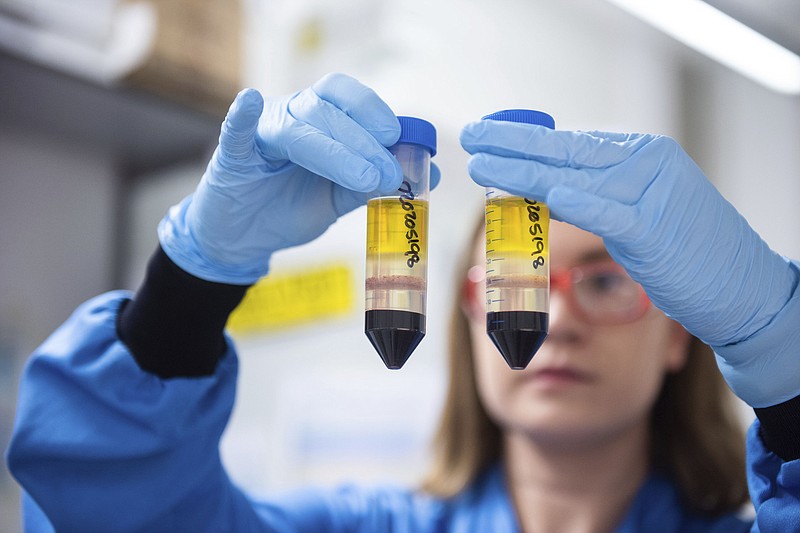LONDON (AP) - Drugmaker AstraZeneca said Monday that late-stage trials showed its COVID-19 vaccine is highly effective, buoying the prospects of a relatively cheap, easy-to-store product that may become the vaccine of choice for the developing world.
The results are based on an interim analysis of trials in the U.K. and Brazil of a vaccine developed by Oxford University and manufactured by AstraZeneca. No hospitalizations or severe cases of COVID-19 were reported in those receiving the vaccine.
AstraZeneca is the third major drug company to report late-stage data for a potential COVID-19 vaccine as the world waits for scientific breakthroughs that will end a pandemic that has pummeled the world economy and led to 1.4 million deaths. But unlike the others, the Oxford-AstraZeneca vaccine doesn't have to be stored at freezer temperatures, making it potentially easier to distribute, especially in developing countries.
"I think these are really exciting results," Dr. Andrew Pollard, chief investigator for the trial, said at a news conference. "Because the vaccine can be stored at fridge temperatures, it can be distributed around the world using the normal immunization distribution system. And so our goal to make sure that we have a vaccine that was accessible everywhere, I think we've actually managed to do that."
The Oxford-AstraZeneca vaccine was 90 percent effective in preventing COVID-19 in one of the dosing regimens tested; it was less effective in another. Earlier this month, rival drugmakers Pfizer and Moderna reported preliminary results from late-stage trials showing their vaccines were almost 95 percent effective.
While the AstraZeneca vaccine can be stored at 36-46 degrees Fahrenheit, the Pfizer and Moderna products must be stored at freezer temperatures. In Pfizer's case, it must be kept at the ultra-cold temperature of around minus-94 Fahrenheit.
The AstraZeneca vaccine is also cheaper.
AstraZeneca, which has pledged it won't make a profit on the vaccine during the pandemic, has reached agreements with governments and international health organizations that put its cost at about $2.50 a dose. Pfizer's vaccine costs about $20, while Moderna's is $15-$25, based on agreements the companies have struck to supply their vaccines to the U.S. government.
All three vaccines must be approved by regulators before they can be widely distributed.
Oxford researchers and AstraZeneca stressed they weren't competing with other projects and said multiple vaccines would be needed to reach enough of the world's population to end the pandemic.
"We need to be able to make a lot of vaccine for the world quickly, and it's best if we can do it with different technologies so that if one technology runs into a roadblock, then we've got alternatives, we've got diversity," professor Sarah Gilbert, a leader of the Oxford team, told the Associated Press. "Diversity is going to be good here, but also in terms of manufacturing, we don't want to run out of raw materials."
AstraZeneca said it will immediately apply for early approval of the vaccine where possible, and it will seek an emergency use listing from the World Health Organization, so it can make the vaccine available in low-income countries.
The AstraZeneca trial looked at two different dosing regimens. A half-dose of the vaccine followed by a full dose at least one month later was 90 percent effective. Another approach, giving patients two full doses one month apart, was 62 percent effective.
That means, overall, when both ways of dosing are considered, the vaccine showed an efficacy rate of 70 percent.
Gilbert said researchers aren't sure why giving a half-dose followed by a larger dose was more effective, and they plan to investigate further. However, the answer is probably related to providing exactly the right amount of vaccine to get the best response, she said.
"It's the Goldilocks amount that you want, I think, not too little and not too much. Too much could give you a poor quality response as well " she said. "I'm glad that we looked at more than one dose because it turns out to be really important."
The vaccine uses a weakened version of a common cold virus that is combined with genetic material for the characteristic spike protein of the virus that causes COVID-19. After vaccination, the spike protein primes the immune system to attack the virus if it later infects the body.
The results reported Monday come from trials in the U.K. and Brazil that involved 23,000 people. Of those, 11,636 people received the vaccine - while the rest got a placebo.
Overall, there were 131 cases of COVID-19. Details on how many people in the various groups became ill weren't released Monday, but researchers said they will be published in the next 24 hours.

